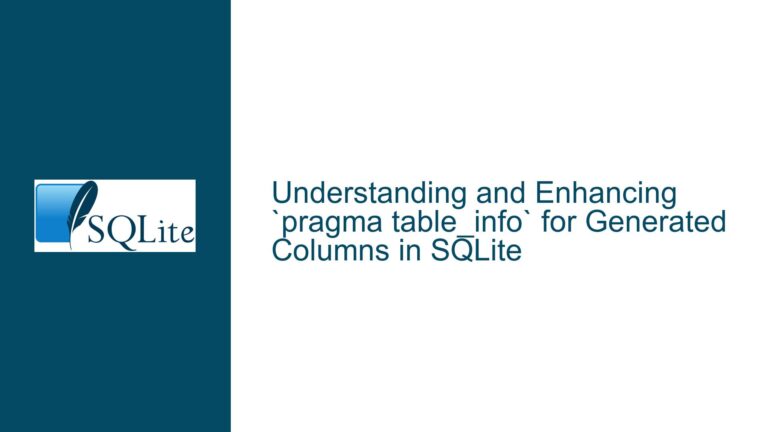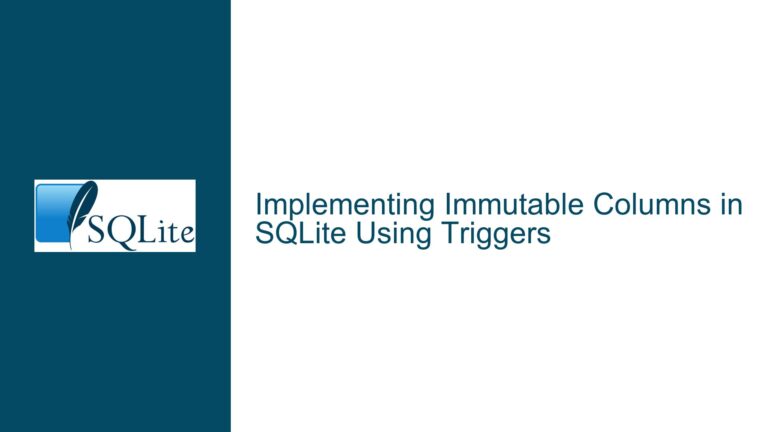Autonumbering Failure in SQLite: BranchID Remains Null
Issue Overview: Autonumbering Failure in SQLite Table Creation
The core issue revolves around the failure of SQLite to automatically assign a unique integer value to the BranchID column in the Branch table when a new row is inserted. This behavior is unexpected because the BranchID column is defined as an INTEGER PRIMARY KEY, which, in SQLite, should automatically generate a unique integer value if no value is explicitly provided during insertion. This feature is commonly referred to as "autonumbering" or "auto-increment" behavior.
In the provided scenario, the user attempts to insert a new row into the Branch table without specifying a value for BranchID, expecting SQLite to automatically assign the next available integer. However, instead of generating a new value, the BranchID remains NULL. This issue is particularly perplexing because the same schema and insertion logic work correctly in an older version of SQLite (3.40.0) but fail in a newer version (3.43.2).
The Branch table schema is defined as follows:
CREATE TABLE Branch (
BranchID INTEGER PRIMARY KEY,
Name varchar(100) DEFAULT NULL,
Office varchar(15) DEFAULT NULL,
Address varchar(100) DEFAULT NULL,
OpenDate datetime DEFAULT NULL
);
The user’s insertion attempt is:
INSERT INTO Branch VALUES (NULL, 'foo', 'bar', 'baz', 'faz');
The expected behavior is for SQLite to assign the next available integer to BranchID, but instead, the BranchID remains NULL.
Possible Causes: Why Autonumbering Fails in SQLite
Several factors could contribute to the failure of autonumbering in SQLite, particularly when dealing with the BranchID column in the Branch table. Below are the most plausible explanations for this behavior:
1. SQLite Version Differences
The user reports that the schema and insertion logic work correctly in SQLite version 3.40.0 but fail in version 3.43.2. This discrepancy suggests that there may have been changes in how SQLite handles INTEGER PRIMARY KEY columns between these versions. While SQLite is generally backward-compatible, subtle changes in behavior can occur, especially in edge cases or when dealing with implicit features like autonumbering.
2. Implicit vs. Explicit Autonumbering
In SQLite, the autonumbering behavior for INTEGER PRIMARY KEY columns is implicit. This means that if no value is provided for such a column during insertion, SQLite automatically assigns the next available integer. However, this behavior relies on the column being strictly defined as INTEGER PRIMARY KEY. Any deviation, such as additional constraints or modifiers, could disrupt this behavior. For example, if the column were defined as INTEGER PRIMARY KEY AUTOINCREMENT, the behavior would be slightly different, and the failure might indicate a misunderstanding of how AUTOINCREMENT works in SQLite.
3. NULL Handling in SQLite
SQLite treats NULL values uniquely. When a NULL value is explicitly inserted into an INTEGER PRIMARY KEY column, SQLite may interpret this as a directive to assign the next available integer. However, if the NULL value is not handled correctly due to a bug or misconfiguration, the column might remain NULL instead of being populated with an integer.
4. Schema Validation Issues
The schema definition for the Branch table appears correct at first glance, but subtle issues could exist. For example, if the BranchID column were inadvertently defined with additional constraints or modifiers, it could disrupt the autonumbering behavior. Additionally, if the table were created with a different schema in an older version of SQLite and then migrated to a newer version, schema validation issues could arise.
5. Database File Corruption
Although less likely, database file corruption could also cause unexpected behavior, including the failure of autonumbering. If the database file were corrupted during creation or migration, SQLite might fail to correctly assign values to INTEGER PRIMARY KEY columns.
Troubleshooting Steps, Solutions & Fixes: Resolving Autonumbering Issues in SQLite
To address the autonumbering failure in the Branch table, follow these detailed troubleshooting steps and solutions:
1. Verify SQLite Version Compatibility
Begin by verifying the SQLite version in use. Run the following command to check the SQLite version:
SELECT sqlite_version();
If the version is 3.43.2, consider downgrading to 3.40.0 to see if the issue persists. If the issue is resolved in the older version, it confirms that the problem is related to changes in SQLite’s behavior between versions. In this case, review the SQLite changelog for any relevant updates or bug fixes related to INTEGER PRIMARY KEY handling.
2. Explicitly Define Autonumbering Behavior
To ensure consistent behavior, explicitly define the autonumbering behavior for the BranchID column. Modify the CREATE TABLE statement to include the AUTOINCREMENT keyword:
CREATE TABLE Branch (
BranchID INTEGER PRIMARY KEY AUTOINCREMENT,
Name varchar(100) DEFAULT NULL,
Office varchar(15) DEFAULT NULL,
Address varchar(100) DEFAULT NULL,
OpenDate datetime DEFAULT NULL
);
The AUTOINCREMENT keyword ensures that SQLite always assigns a unique integer value to the BranchID column, even if rows are deleted. However, note that using AUTOINCREMENT incurs a slight performance overhead, as SQLite must maintain a separate table to track the highest assigned value.
3. Check for Schema Validation Issues
Carefully review the schema definition for the Branch table to ensure there are no hidden issues. Use the .schema command in the SQLite shell to inspect the table definition:
.schema Branch
Ensure that the BranchID column is defined strictly as INTEGER PRIMARY KEY or INTEGER PRIMARY KEY AUTOINCREMENT. If additional constraints or modifiers are present, remove them and recreate the table.
4. Test NULL Handling
To verify how SQLite handles NULL values in the BranchID column, perform a series of test insertions. First, insert a row without specifying a value for BranchID:
INSERT INTO Branch (Name, Office, Address, OpenDate) VALUES ('foo', 'bar', 'baz', 'faz');
Next, insert a row with an explicit NULL value for BranchID:
INSERT INTO Branch VALUES (NULL, 'foo2', 'bar2', 'baz2', 'faz2');
Finally, query the table to inspect the results:
SELECT * FROM Branch;
If the BranchID column is populated correctly in both cases, the issue may be related to how NULL values are handled in the specific SQLite version.
5. Recreate the Database File
If the issue persists, recreate the database file from scratch. Export the existing schema and data to a SQL script:
.output backup.sql
.dump
Then, create a new database file and import the script:
sqlite3 new_banking.db < backup.sql
This process ensures that any potential corruption or schema validation issues in the original database file are resolved.
6. Inspect Database File Integrity
Use SQLite’s built-in integrity check to verify the database file’s integrity:
PRAGMA integrity_check;
If the integrity check reports any issues, consider exporting the data to a new database file as described in the previous step.
7. Consult SQLite Documentation and Community
If none of the above steps resolve the issue, consult the official SQLite documentation and community forums for additional insights. The SQLite documentation provides detailed information on INTEGER PRIMARY KEY behavior and autonumbering. Additionally, the SQLite community forums are a valuable resource for troubleshooting specific issues and learning from others’ experiences.
By following these troubleshooting steps and solutions, you can systematically identify and resolve the autonumbering failure in the Branch table. Whether the issue stems from version differences, schema validation, or database file integrity, a thorough and methodical approach will help ensure that your SQLite database functions as expected.






